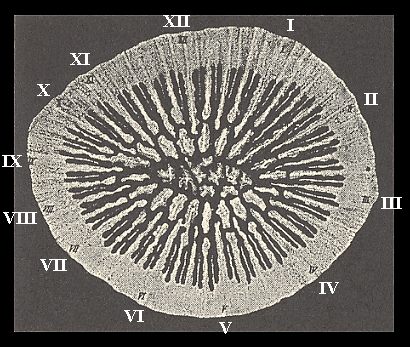
The Hexacorallia can all be considered to belong to the Oxystaura hexaphragma, although there are some that are close to Isopola hexactinota.

Figure 1. Polished section through the skeleton of Caryophyllia cyatus.
Periphery : Theca. Extending inwards from the theca : the Septa ( I--XII, first and second cycle ), Pali, and in the center the Columella.
( After HERTWIG, R., 1907, Lehrbuch der Zoologie )
In Caryophyllia, as in all Hexacorallia, the septa are laid down in multiples of six. When the coral is very young the corallum (the skeleton of the individual polyp) is simply a basal plate with six small prosepta inserted between the mesenteries (soft radially placed lamellae). Later the metasepta appear, and there may be two or three generations (cycles) of these so that the whole becomes multiseptate (See Figure 1). A slight shift of their spacing throughout growth as the corallum becomes elliptical imparts the characteristic biradial symmetry. Throughout growth new material is added to the exposed edges of the septa and to the epitheca (theca) so that the coral expands as it grows (CLARKSON, E., 1980, Invertebrate palaeontology and Evolution).
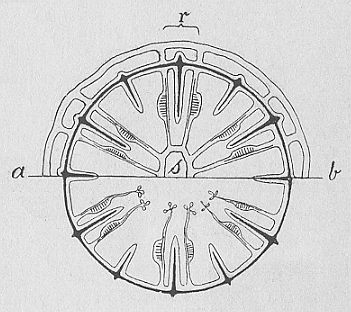
Figure 2. Diagram of a transverse section through the soft parts and skeleton of a hexacorallium. Above the line ab the section runs through the gullet, below the line ab it runs below the gullet. The secreted hard parts black, r directional septa, s gullet.
( After HERTWIG, R., 1907, Lehrbuch der Zoologie )
The next three Figures depict the successive formation of septa in different hexacorallia.
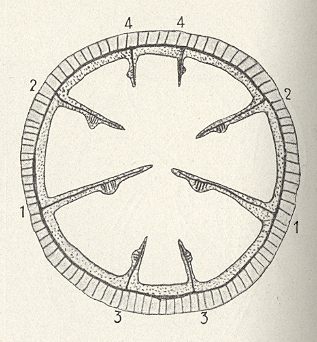
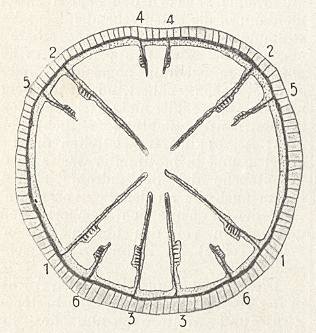
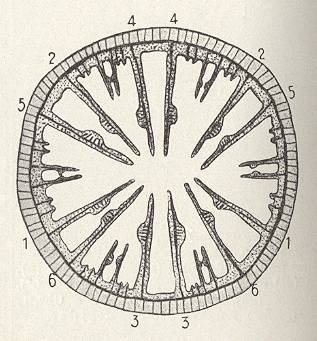
In Figure 5 we see that in Hexacorallia still more septa are formed after the first six pairs have been laid down. Further it is known that also the number of tentacles more and more increases.
While in the Octocorallia the number of septa does not, after the four pairs have been initiated more or less simultaneously, exceed the number 8, in the Hexacorallia the initial pairs of septa are not laid down simultaneously, but after each other in a definite order. Before the number of six pairs is reached, also a stadium of four pairs appears, which, although displaying a somewhat different ordering of the muscles, could be compared with the Octocorallia. ( MAAS, O., 1912, in Handwörterbuch der Naturwissenschaften, Volume II, p. 685/6 ).
The next Figure is the same as Figure 5, but shows the approximate boundaries of the six antimers.
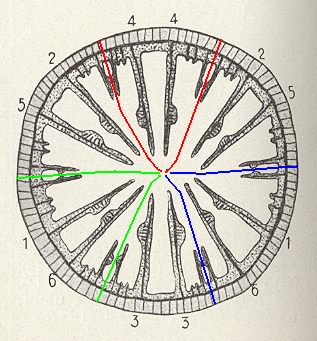
Figure 5a. The s i x a n t i m e r s are outlined in the image of Figure 5.
Strictly, there are only two mirror planes : We can indicate them by two lines, intersecting each other at right angles in the center of the section through the coral, and lying in the plane of the drawing, one horizontally, the other vertically. These two lines are the directional axes (directional cross axes) and are not equivalent. This complies (promorphologically) with the fact that the transverse section of the gullet (not present -- i.e. not hit upon -- in the transverse section depicted) is flattened, and as such lies along one of the directional axes. So the basic form of the coral is indeed that of the Hexaphragma (six antimers, two mirror planes containing the heteropolar main body axis, which is perpendicular to the plane of the drawing).
The next diagrams depict the initial septal emplacement in the order Actiniaria (sea-anemones) of the Hexacorallia. The Actiniaria do not secrete a skeleton, so their septa only involve soft parts. The number of septa does often not comply with the 'sixness' of most other Hexacorallia (KILIAS, R., 1971, in Neue grosse Tier-enzyklopädie, p. 141).
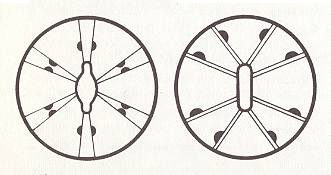
Figure 6. Diagram of the initial septal emplacement in Anthozoa.
Left image : six-fold actiniarium (Hexacorallia) with six pairs of septa, which all possess longitudinal muscles in a definite ordering.
Right image : eight-fold actiniarium (Hexacorallia). One member of each of the eight pairs of septa bears longitudinal muscles.
( After KILIAS, R., 1971, in Neue grosse Tier-enzyklopädie )
In the left diagram of Figure 6 we have the same situation as in Figure 5 (and 5a). In the right diagram there is only one mirror plane present (running vertically through the diagram), if we take the ordering of the muscles (symbolized by small black crescents) into account. If we ignore this ordering, then we have to do with a basic form belonging to the Octophragma.